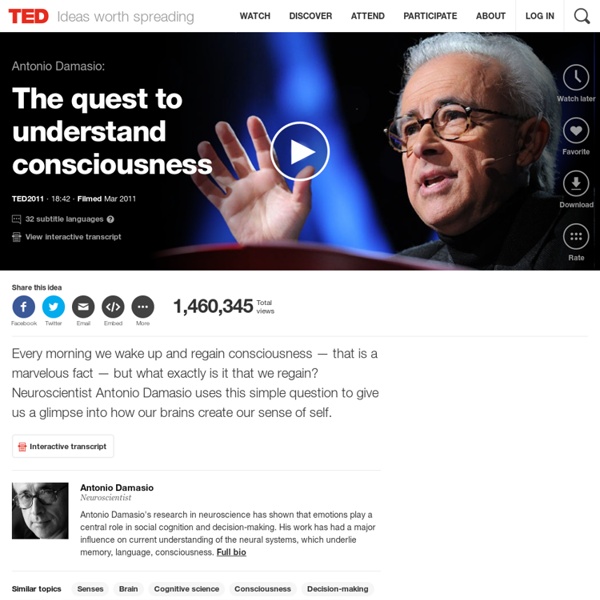



Consciousness as a Self-Organizing Process Allan Combs University of North Carolina at Asheville Saybrook Graduate School sourceintegralis.org Sally Goerner Triangle Center for the Study of Complex Systems 374 Wesley Court, Chapel Hill, NC 27515 Abstract The evolution of consciousness is seen in the context of energy driven evolution in general, where energy and information are understood as two sides of the same coin. From this perspective consciousness is viewed as an ecological system in which streams of cognitive, perceptual, and emotional information form a rich complex of interactions, analogous to the interactive metabolism of a living cell. Key Words autopoiesis, chaos, consciousness, energy, evolution, information, states, system 1. Old ideas of information as "neg-entropy" were steeped in the Mechanistic Age thermodynamic notion that the universe is losing organized energy and running down directly toward disorder. Energy driven evolution has been conceptualized as represented at several levels of increasing complexity.
Embodied cognition and body psychotherapy: The construction of new therapeutic environments | Röhricht | Sensoria: A Journal of Mind, Brain & Culture Embodied cognition and body psychotherapy: The construction of new therapeutic environments Frank Röhricht, Shaun Gallagher, Ulfried Geuter, Daniel D. Hutto Abstract New approaches in the philosophy of mind defend the idea that basic forms of cognition and human intersubjectivity are deeply and inextricably embodied and embedded. Keywords embodiment; enactivism; embodied cognition; body psychotherapy; therapeutic environment; philosophy; intersubjectivity What is it like to be a bat? What is it like to be a bat? Thomas Nagel Consciousness is what makes the mind-body problem really intractable. Every reductionist has his favorite analogy from modern science. Conscious experience is a widespread phenomenon. We may call this the subjective character of experience. While an account of the physical basis of mind must explain many things, this appears to be the most difficult. Let me first try to state the issue somewhat more fully than by referring to the relation between the subjective and the objective, or between the pour-soi and the en-soi. I assume we all believe that bats have experience. I have said that the essence of the belief that bats have experience is that there is something that it is like to be a bat. Our own experience provides the basic material for our imagination, whose range is therefore limited. So if extrapolation from our own case is involved in the idea of what it is like to be a bat, the extrapolation must be incompletable.
15 Years of Cutting-Edge Thinking on Understanding the Mind by Maria Popova What mirror neurons have to do with Abu Ghraib, the science of religion, and how happiness flourishes. For the past 15 years, literary-agent-turned-crusader-of-human-progress John Brockman has been a remarkable curator of curiosity, long before either “curator” or “curiosity” was a frivolously tossed around buzzword. His Edge.org has become an epicenter of bleeding-edge insight across science, technology and beyond, hosting conversations with some of our era’s greatest thinkers (and, once a year, asking them some big questions.) Last month marked the release of The Mind, the first volume in The Best of Edge Series, presenting eighteen provocative, landmark pieces — essays, interviews, transcribed talks — from the Edge archive. The anthology reads like a who’s who of Brain Pickings favorites across psychology, evolutionary biology, social science, technology and more. Here’s a small sampling of the treasure chest between The Mind’s covers: Iconic neuroscientist V.
Mood Map Emotions create subjective feelings that are often evaluated as “feeling good” or “feeling bad”. Emotions also tend to increase or decrease our arousal level, which we often describe as increasing or lowering our energy level. The map shown here places each of the major emotions roughly where they are often experienced in these two dimensions. The placement of each emotion on this map is only approximate and very subjective. Each emotion can vary greatly in intensity. For example anger can range from mild irritation to intense rage. Two other, more subtle dimensions also differentiate among emotions. These charts are based on the following data obtained from Averill, J.R. (1975) “A semantic atlas of emotional concepts”, JSAS Catalog of Selected Documents in Psychology, University of Massachusetts, Amherst, USA, Vol. 5, No. 330, pp.1-64 (Ms No. 1103). The “activation” dimension is labeled High/Low energy and the “evaluation” dimension is labeled “Feel good/Feel bad” on the upper chart.